Wi-Fi Site Surveys, Analysis, Troubleshooting runs on a MacBook (macOS 11+) or any laptop (Windows 7/8/10/11) with a standard 802.11a/b/g/n/ac/ax wireless network adapter.
Measure WiFi Strength on Windows: Top 3 Best Apps Compared
Discover the best WiFi signal strength meter apps for Windows to fix connection issues and improve coverage.
Why download a dedicated WiFi strength meter when you can see how strong your WiFi connection is just by looking at the WiFi indicator icon in the taskbar? Because the WiFi indicator icon doesn’t tell you the full story.
Accurately measuring your WiFi signal strength is crucial for pinpointing connectivity problems and maximizing coverage. The right software streamlines this process, giving you in-depth information about network range, interference sources, and ideal router positioning — key factors for improving performance.
Yet, with so many apps on the market, finding the perfect fit can be difficult. To simplify your search, we’ve highlighted three standout WiFi signal strength meter applications, each geared toward different user needs. Let’s explore how they can help you optimize your wireless setup.
Top 3 Best WiFi Signal Strength Meter Apps
- NetSpot — both a WiFi signal strength visualizer and a WiFi discovery and analysis tool.
- Wi-Fi Analyzer — WiFi signal strength meter app for computers running the Windows operating system.
- Wireshark — is the polar opposite of WiFi Analyzer.
NetSpot is our favorite WiFi signal strength meter app because it combines simplicity with powerful features at an affordable price. NetSpot is a WiFi signal strength visualizer a WiFi discovery analysis, and planning tool. Changing between modes of operation is as simple as clicking on a button, and the same ease of use is characteristic for the rest of the software.
-

Inspector Mode
Lets you take quick snapshots of all WiFi networks in your area.
-

Survey Mode
Makes it easy to create detailed WiFi strength heat maps.
-

Planning Mode
Enables you to simulate and plan your WiFi network's layout and coverage.
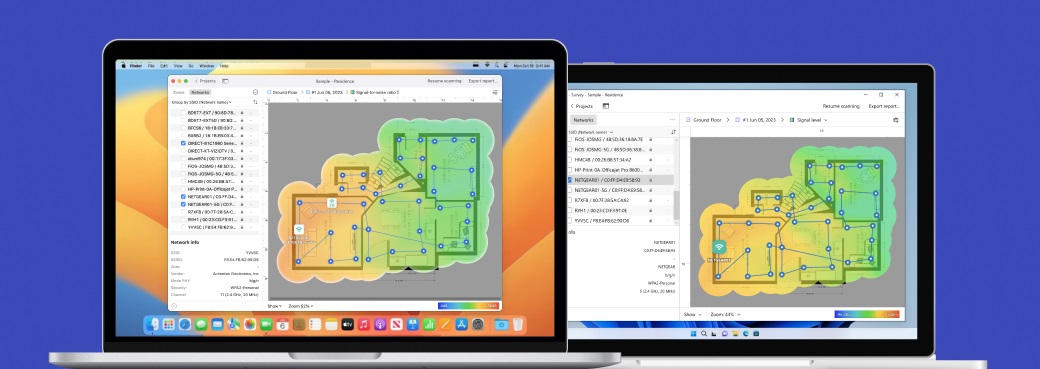
These three modes collectively equip NetSpot to handle a wide range of wireless analyses and optimizations, making it a truly universal solution for WiFi assessments.
To detect and evaluate nearby WiFi networks, you choose Inspector Mode and give NetSpot a short while to detect all WiFi networks and automatically check WiFi signal strength of each one.
NetSpot can detect even hidden WiFi networks, displaying channel info, transmit rate, vendor, security type, band, and other useful information.
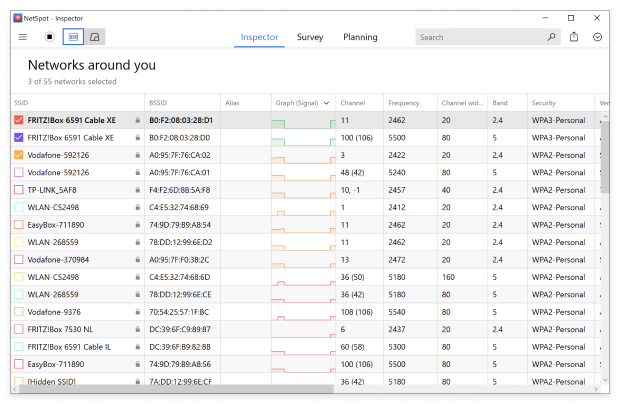
The Channel Overlap graph helps visualize interference, supporting 6 GHz Wi-Fi 6E networks.
The Signal Strength graph tracks real-time fluctuations, making it easy to spot weak signals and unstable connections.
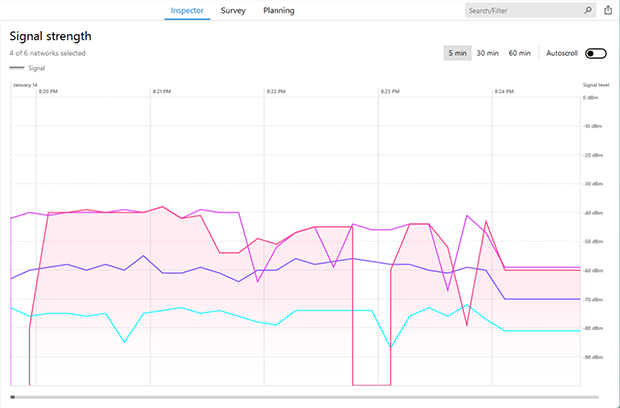
If you need a deeper, more visual analysis of your Wi-Fi network, switch to Survey Mode. It lets you analyze your WiFi network and map out its coverage. To draw a WiFi signal strength heatmap with NetSpot, you first have to supply NetSpot with a map of the area you want to visualize.
You can either upload an existing map or create one from scratch. With the map ready, you walk from one place to the next until you’ve measured WiFi strength everywhere.
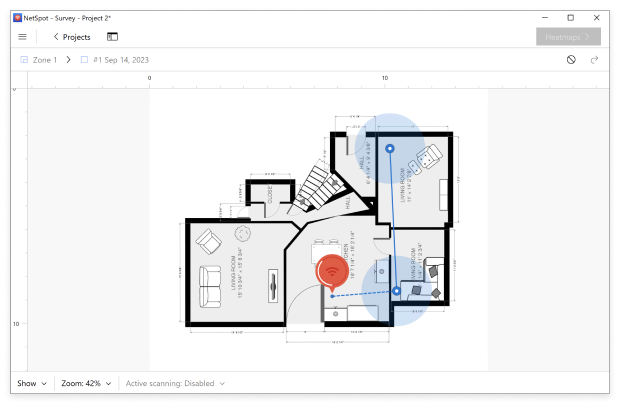
NetSpot then analyzes the gathered data and turns it into a signal strength heatmap.
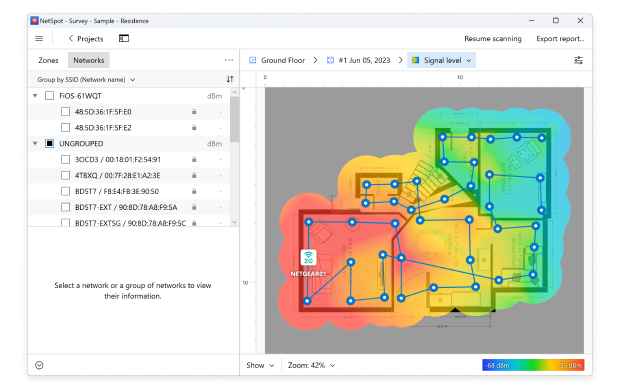
Survey Mode provides over 20 different heatmap types, ensuring a comprehensive, all-around analysis of your network by highlighting coverage quality, interference sources, and other critical performance metrics. With this broad range of visualizations, you can go beyond a simple signal check and conduct a thorough network analysis, ensuring optimal performance.
If you plan to set up a new Wi-Fi network or upgrade your current one, you can use NetSpot's planning mode to visualize the predicted signal strength of your future network and even virtually test different access points before making a purchase.
It allows you to create a detailed heatmap that predicts Wi-Fi coverage, helping you identify optimal access point placements and potential dead zones. By leveraging these predictive visualizations, you can ensure a robust and efficient network setup tailored to your specific environment.
-
User-friendly interface
-
Comprehensive WiFi analysis in real-time
-
Graphical representation
-
More than 20 types of Wi-Fi heatmaps
-
Cross-platform availability
-
Three modes of operation
-
Detailed reports
-
None
- Summary recommendation: Get NetSpot
WiFi Analyzer is a barebones WiFi signal strength meter app for computers running the Windows operating system. With a simple, user-friendly interface, it provides basic network analysis features and is ideal for casual users who don’t want to delve into the complexities of Wi-Fi. WiFi Analyzer can detect nearby networks, sort them by signal strength, and visualize them on a graph which shows on which channel each network runs.
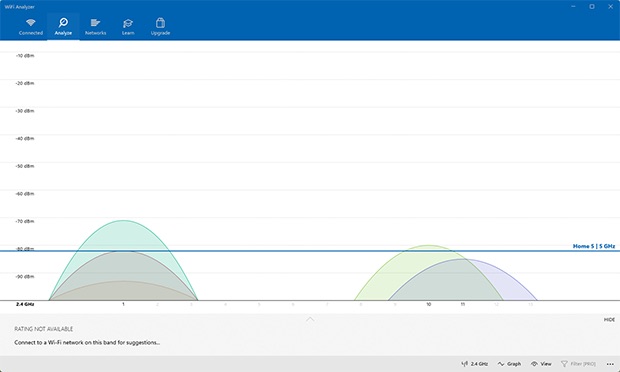
Although it does not currently support Wi-Fi 6E, there’s hope that this feature will be added in a future update.
A tool like this is useful for finding the best open WiFi network in public places or for basic troubleshooting. WiFi Analyzer is available in Windows Store for free.
Pros and Cons
-
Ideal for beginners
-
Free of charge
-
Available in the Microsoft Store
-
Windows only
-
No Wi-Fi heatmap visualization
-
Advertisements in free version
-
No exportable reports
-
Hasn’t seen recent updates
In many ways, Wireshark is the polar opposite of WiFi Analyzer. Just like NetSpot, Wireshark can satisfy the needs of network professionals, but it largely disregards the needs of beginners. Wireshark can analyze wireless network traffic down to individual packets, which is why it’s widely used by software developers and by security experts doing penetration testing.

Don’t expect to know how to use it without reading the manual, though.
Pros and Cons
-
Comprehensive analysis
-
Free and open source
-
FIntegration with Google Earth
-
Support for GPS functionality
-
Real-time capture and offline analysis
-
Can be overwhelming for beginners
-
Resource intensive
-
Complexity for basic needs
-
No built-in visualization tools
-
Manual interpretation required
Comparison Table
| Feature | Signal strength visualization |
| NetSpot | ✅ |
| WiFi Analyzer | ✅ |
| Wireshark | ❌ |
| Feature | Heatmap creation |
| NetSpot | ✅ |
| WiFi Analyzer | ❌ |
| Wireshark | ❌ |
| Feature | Channel interference detection |
| NetSpot | ✅ |
| WiFi Analyzer | ✅ |
| Wireshark | ✅ |
| Feature | Real-time network monitoring |
| NetSpot | ✅ |
| WiFi Analyzer | ✅ |
| Wireshark | ✅ |
| Feature | Beginner-friendly |
| NetSpot | ✅ |
| WiFi Analyzer | ✅ |
| Wireshark | ❌ |
| Feature | Best For |
| NetSpot | Professionals & Home Users |
| WiFi Analyzer | Basic Troubleshooting for Home Users |
| Wireshark | Advanced Network Analysis |
| Feature | Features |
| NetSpot | Wi-Fi heatmaps, signal analysis, network planning |
| WiFi Analyzer | Real-time monitoring, channel recommendations |
| Wireshark | Packet capture, deep traffic inspection |
Why Measure Wi-Fi Strength and What WiFi Signal Strength Meter Apps Do?
After reviewing the top apps, let’s explore why WiFi signal strength test tools are indispensable and how they work.
Many users set up a wireless network, simply where it’s convenient rather than ensuring the best coverage. In reality, Wi-Fi signals weaken over distance, struggle to penetrate walls, and face interference from other networks — leading to slow speeds, unstable connections, and dead zones.
Even the most powerful router can’t guarantee a seamless connection if it’s poorly positioned or if interference goes unchecked. That’s why conducting a WiFi signal strength test is crucial.
The right WiFi signal strength meter apps go beyond displaying real-time signal levels: they analyze wireless networks, detect interference sources, and generate coverage heatmaps.
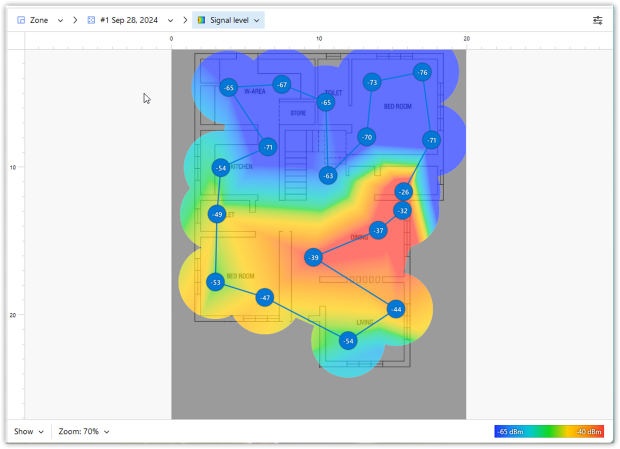
These insights form the foundation for optimization—once you understand the underlying metrics, you can choose an optimal place for the router, pinpoint issues, and resolve them.
Instead of relying on guesswork, you’ll make data-driven decisions about repositioning, channel selection, or advanced configurations — ultimately achieving a more stable, high-performance Wi-Fi experience.
Conclusion
It doesn’t take much time to find a better place for your router with an app like NetSpot, and it also doesn’t take much time to configure the router to perform to its fullest potential. A WiFi signal strength test can reveal weak spots, interference, and other issues affecting your connection, giving you the data needed to make informed adjustments.
So, whenever you find yourself not satisfied with the performance of your wireless network, instead of writing an angry email to your Internet service provider, consider downloading a WiFi signal strength meter app like NetSpot to quickly analyze your network, identify problem areas, and optimize coverage. The chances are that you’ll be able to fix it by yourself in no time.
FAQ
If you want to check WiFi signal strength on Windows, apps like NetSpot can give you a much clearer picture than the standard Wi-Fi indicator. This tool lets you analyze wireless networks, create heatmaps to visualize coverage, and identify sources of interference for better optimization.
Three Best WiFi Signal Strength Meter Apps
- NetSpot — a high-quality WiFi signal strength meter and visualizer with advanced discovery and analysis features.
- WiFi Analyzer — WiFi signal strength meter app for Windows OS.
- Wireshark — is a cross-platform packet analyzer tool.
WiFi signal strength is measured in dBm (decibel-milliwatts). The ideal signal strength depends on your usage:
- -50 dBm or higher — Excellent signal for any application.
- -60 dBm to -67 dBm — Good for video calls, streaming, and gaming.
- -70 dBm — Minimum for web browsing and emails.
- Less than -75 dBm — Unstable connection, likely causing dropped signals and buffering.
You can perform a WiFi signal strength test using NetSpot to check coverage and optimize router placement.
There are several things that you can try to boost WiFi signal on your Windows 11 laptop:
- Update WiFi drivers — Ensure your laptop has the latest drivers for better compatibility and performance.
- Run a WiFi signal strength test — to identify weak spots and optimize router placement use NetSpot or built-in tools.
- Change WiFi channels — Use Inspector Mode in NetSpot to find a less congested channel.
- Upgrade to a USB WiFi adapter — If your laptop has a weak built-in Wi-Fi module, an external USB adapter with an antenna can provide better reception.
- Move closer to the router — Reduce distance and avoid obstacles like walls or furniture.
- Adjust WiFi power settings — In Device Manager, disable Power Saving Mode for WiFi and increase Roaming Aggressiveness if you frequently switch networks.
- Use 5 GHz or 6 GHz instead of 2.4 GHz — If your laptop supports Wi-Fi 6E, switching to 6 GHz can reduce interference.
- Disable Bluetooth (if using 2.4 GHz WiFi) — If your WiFi is on 2.4 GHz, turning off Bluetooth might help reduce interference.
You should also learn how to check WiFi signal strength on Windows to verify that you’ve actually improved your signal and not made it worse.
Several factors can weaken your WiFi signal strength:
- Distance from the router — Signal weakens over longer distances.
- Obstructions — Walls, furniture, and metal surfaces can block signals.
- Interference — Neighboring Wi-Fi networks, microwaves, and Bluetooth devices can cause interference.
- Overcrowded channels — Too many networks on the same channel reduce performance.
- Outdated equipment — Older routers may not support Wi-Fi 6E and newer standards.
Using NetSpot's Channel Overlap graph, you can identify interference and find the best channel for your network.
The best tool to measure WiFi signal strength on Mac is NetSpot. It provides detailed insights into WiFi networks, including signal strength, noise levels, and interference, making it an excellent choice for both casual users and professionals.


